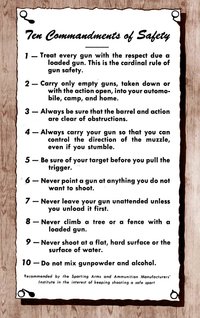Ok I have posted just the rule numbers here and several people seem to not know them? I thought they where universal but I guess not so to share the information these are the four golden rules of Firearms as stated by Jeff Cooper. If you do not know who that is Google him and drink in the wealth of information.
If you have kids they should know these by heart as should anybody who touches a firearm BEFORE they do the touching. IMHO
1. All guns are always loaded. Even if they are not, treat them as if they are.
2. Never let the muzzle cover anything you are not willing to destroy. (For those who insist that this particular gun is unloaded, see Rule 1.)
3. Keep your finger off the trigger till your sights are on the target.
4. Identify your target, and what is behind it. Never shoot at anything that you have not positively identified.
Those will do. We need all four and we do not need five. It should not be necessary to belabor this issue, but life is not perfect.
– Jeff Cooper, Commentaries, Volume 11, Number 4.
If you have kids they should know these by heart as should anybody who touches a firearm BEFORE they do the touching. IMHO
1. All guns are always loaded. Even if they are not, treat them as if they are.
2. Never let the muzzle cover anything you are not willing to destroy. (For those who insist that this particular gun is unloaded, see Rule 1.)
3. Keep your finger off the trigger till your sights are on the target.
4. Identify your target, and what is behind it. Never shoot at anything that you have not positively identified.
Those will do. We need all four and we do not need five. It should not be necessary to belabor this issue, but life is not perfect.
– Jeff Cooper, Commentaries, Volume 11, Number 4.

![Thinking [thinking] [thinking]](/xen/styles/default/xenforo/smilies.vb/010.gif) lol
lol![Wink [wink] [wink]](/xen/styles/default/xenforo/smilies.vb/002.gif)
